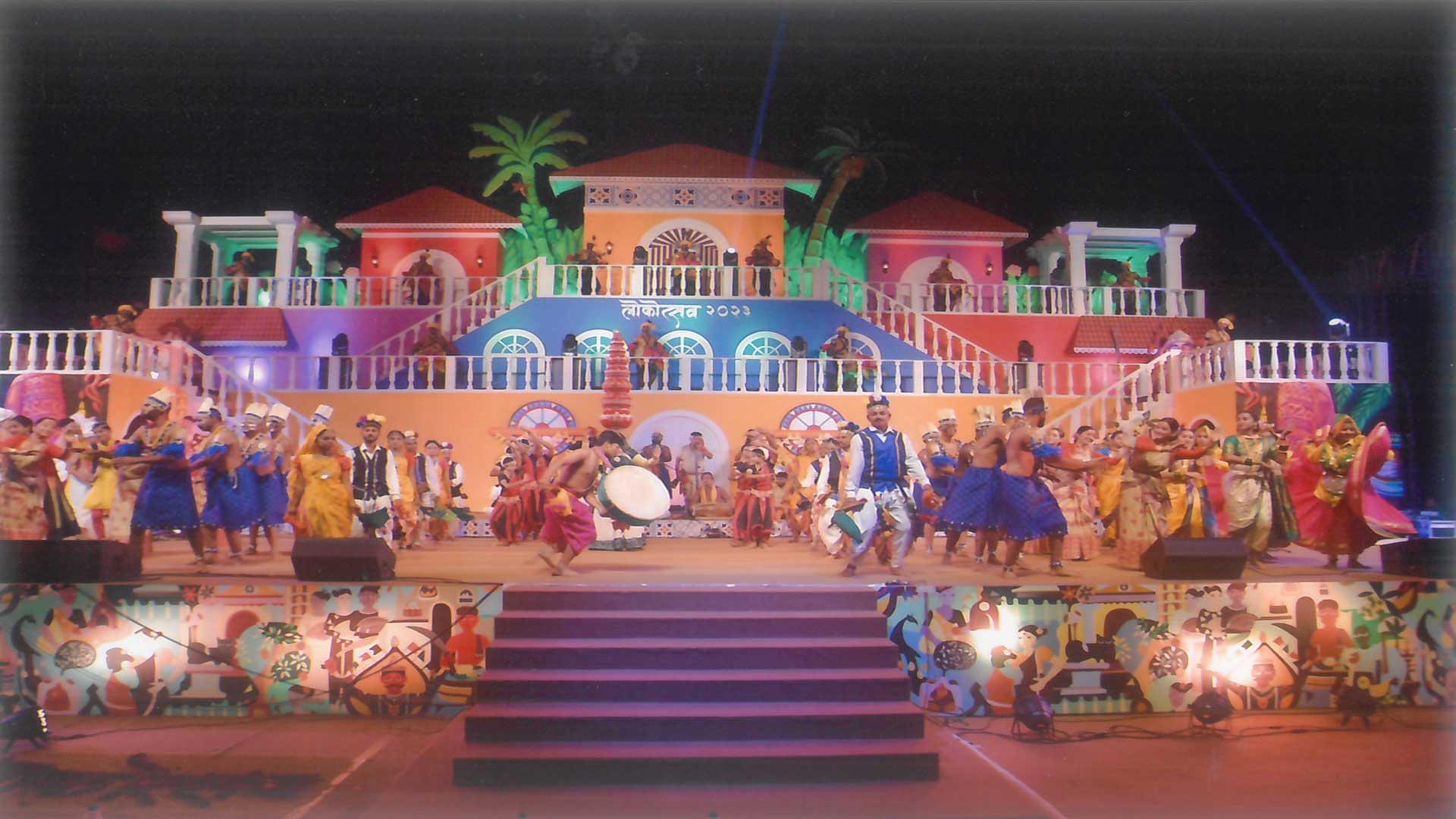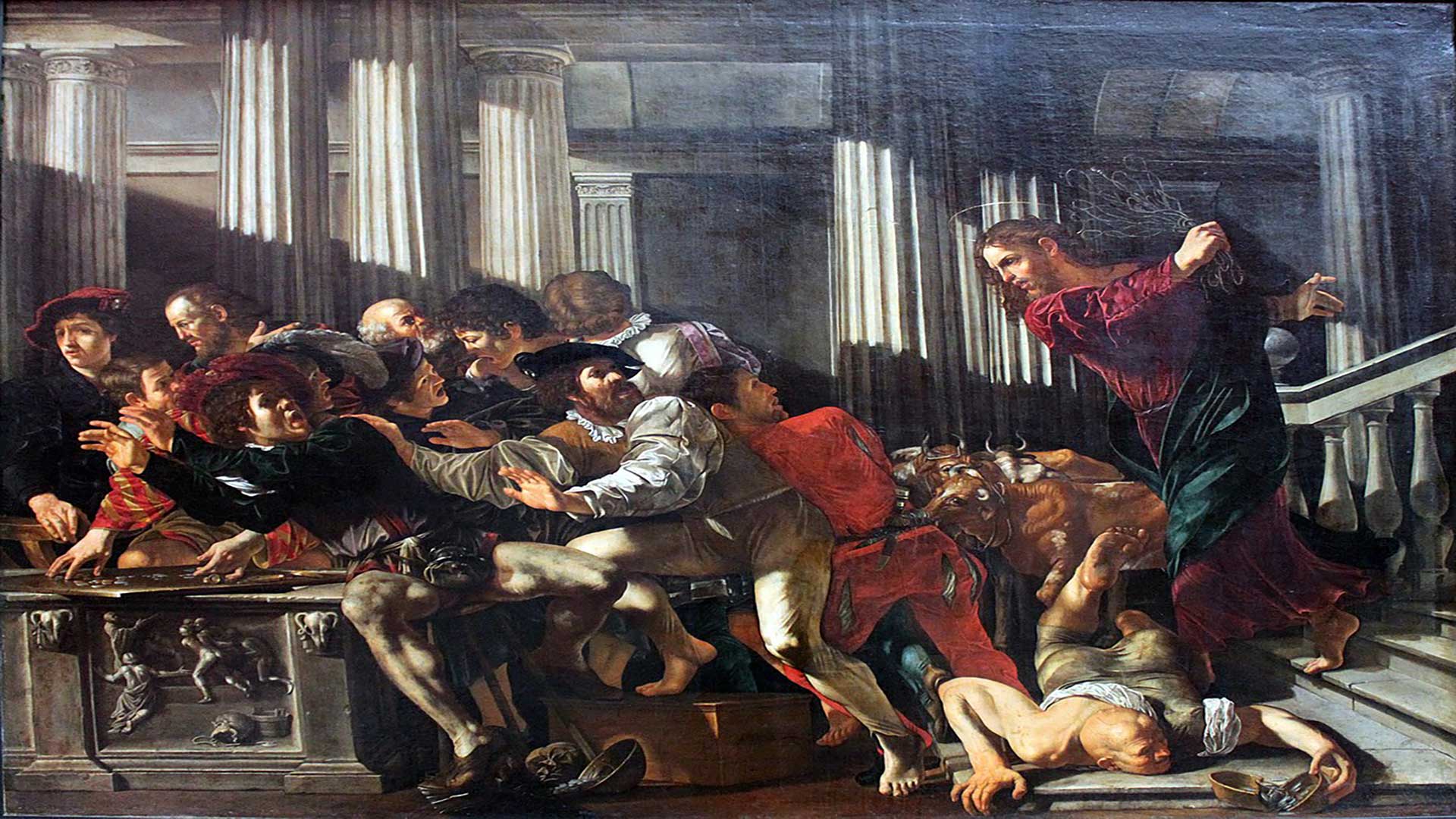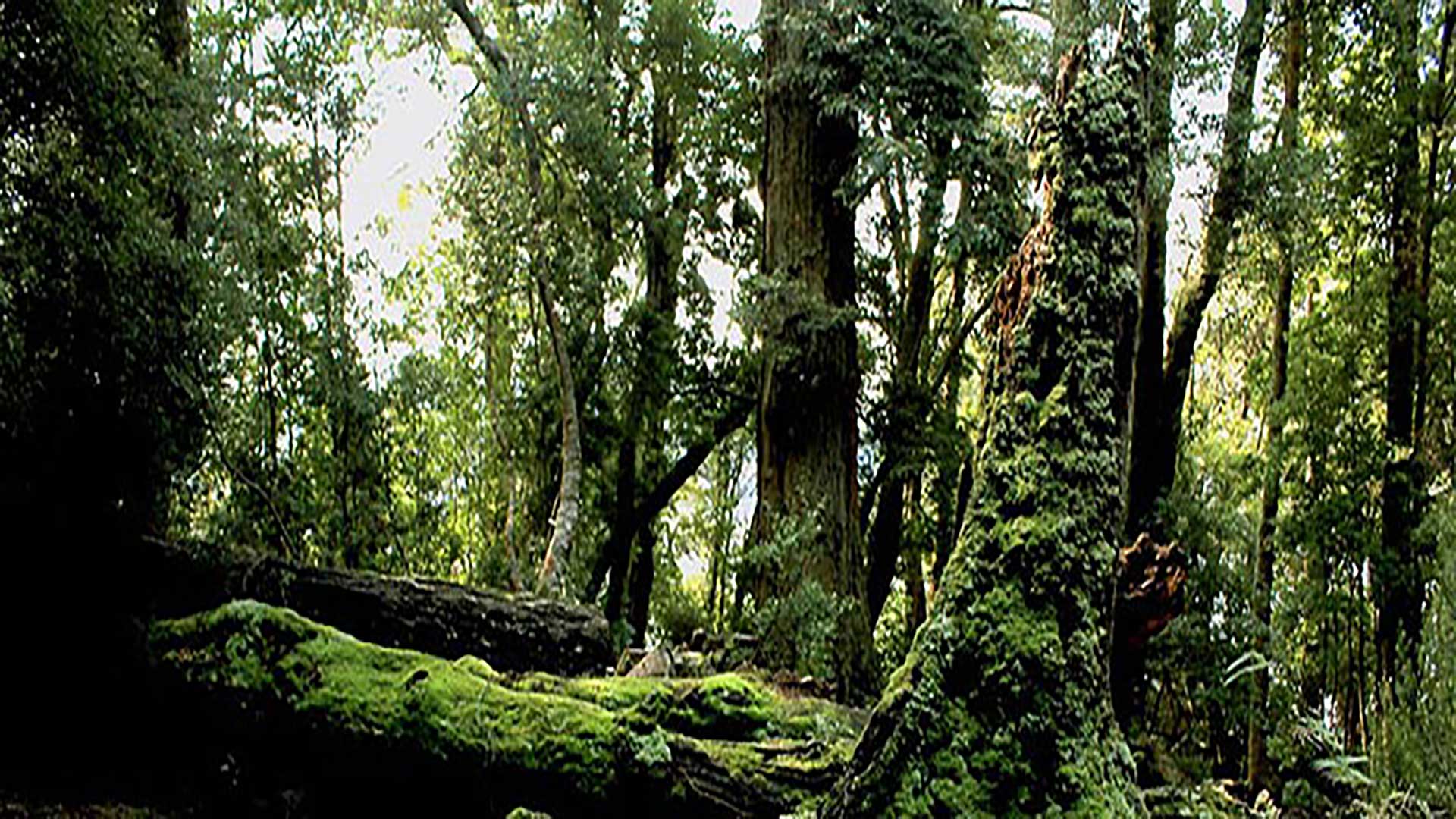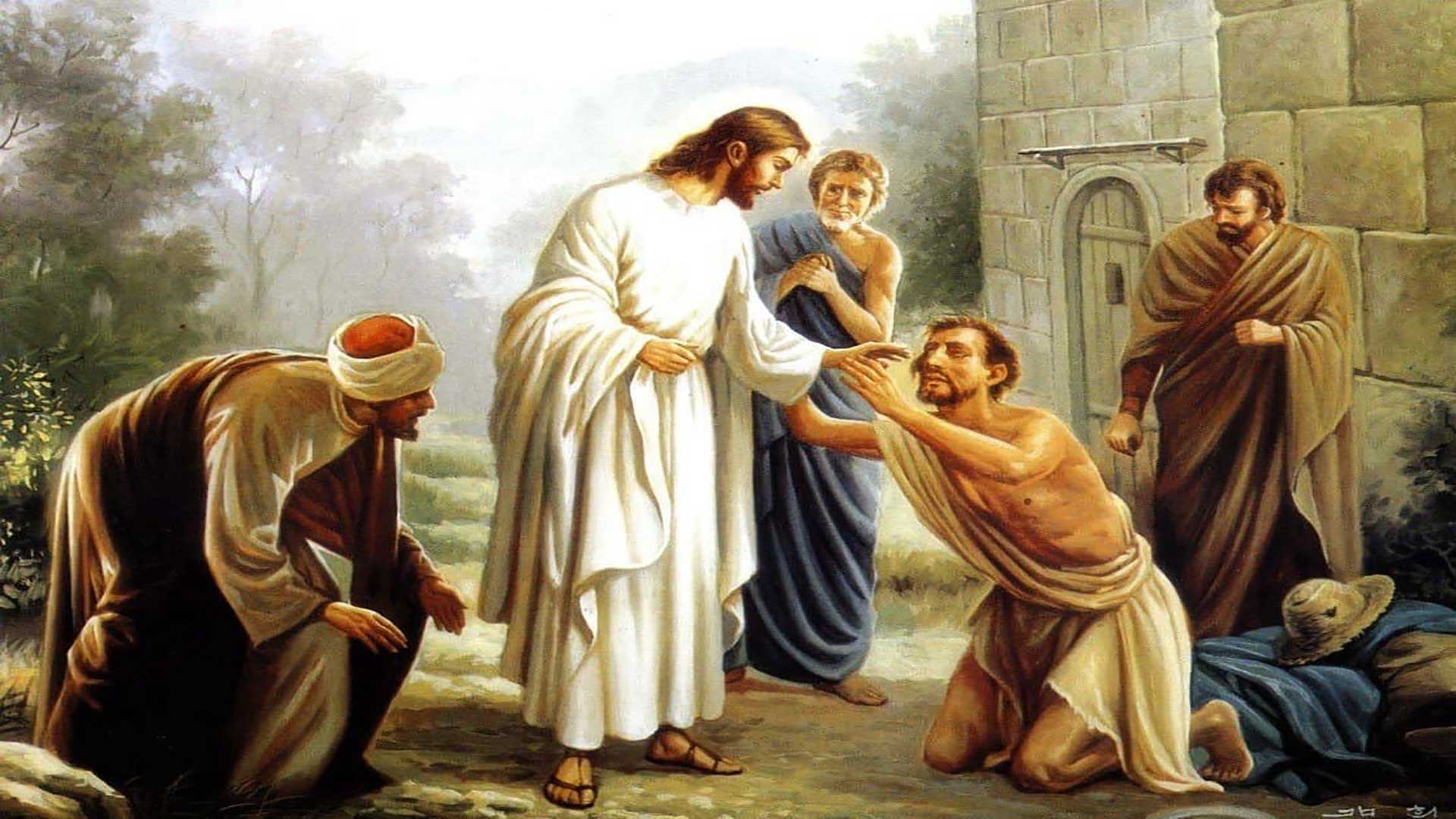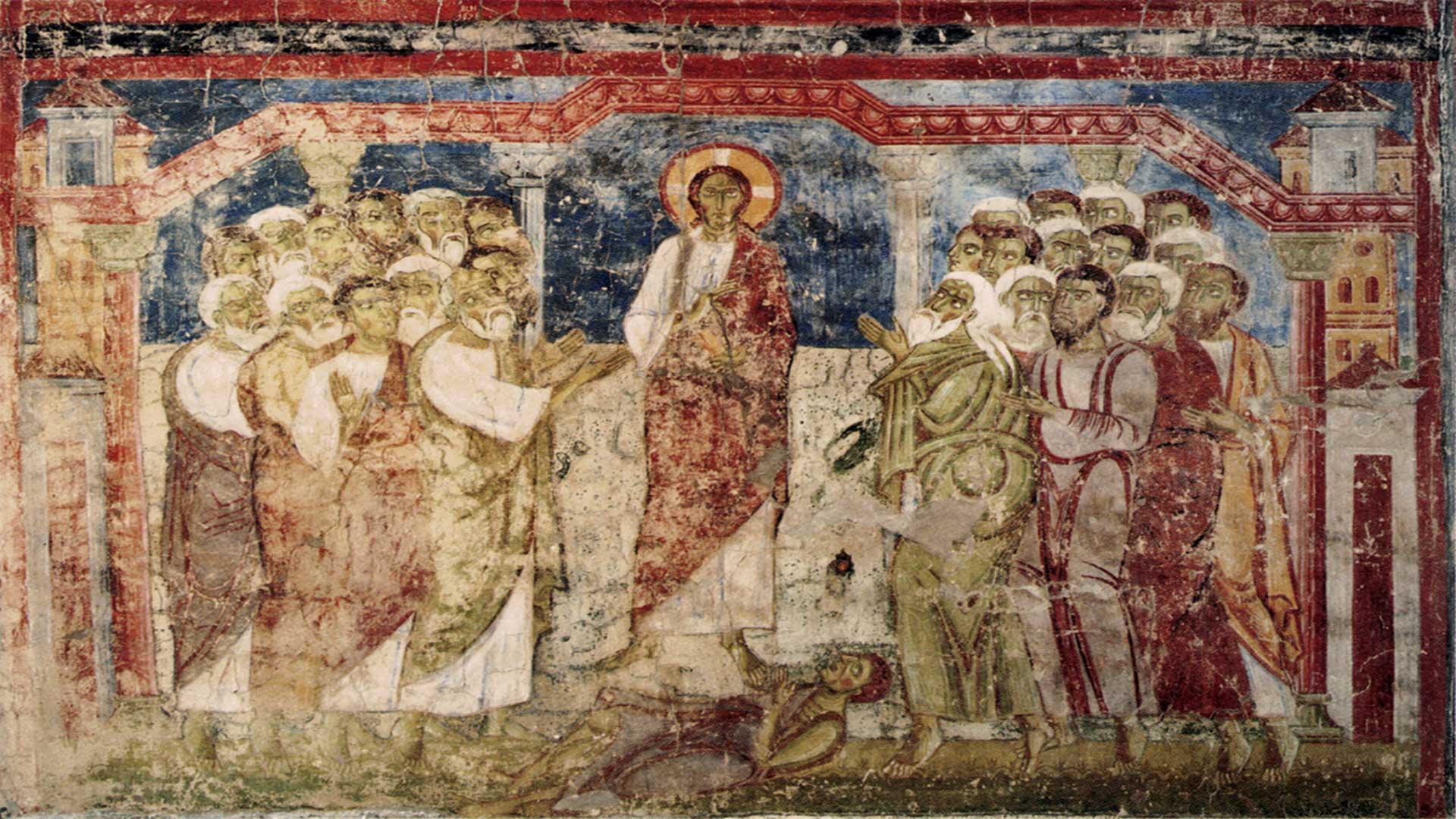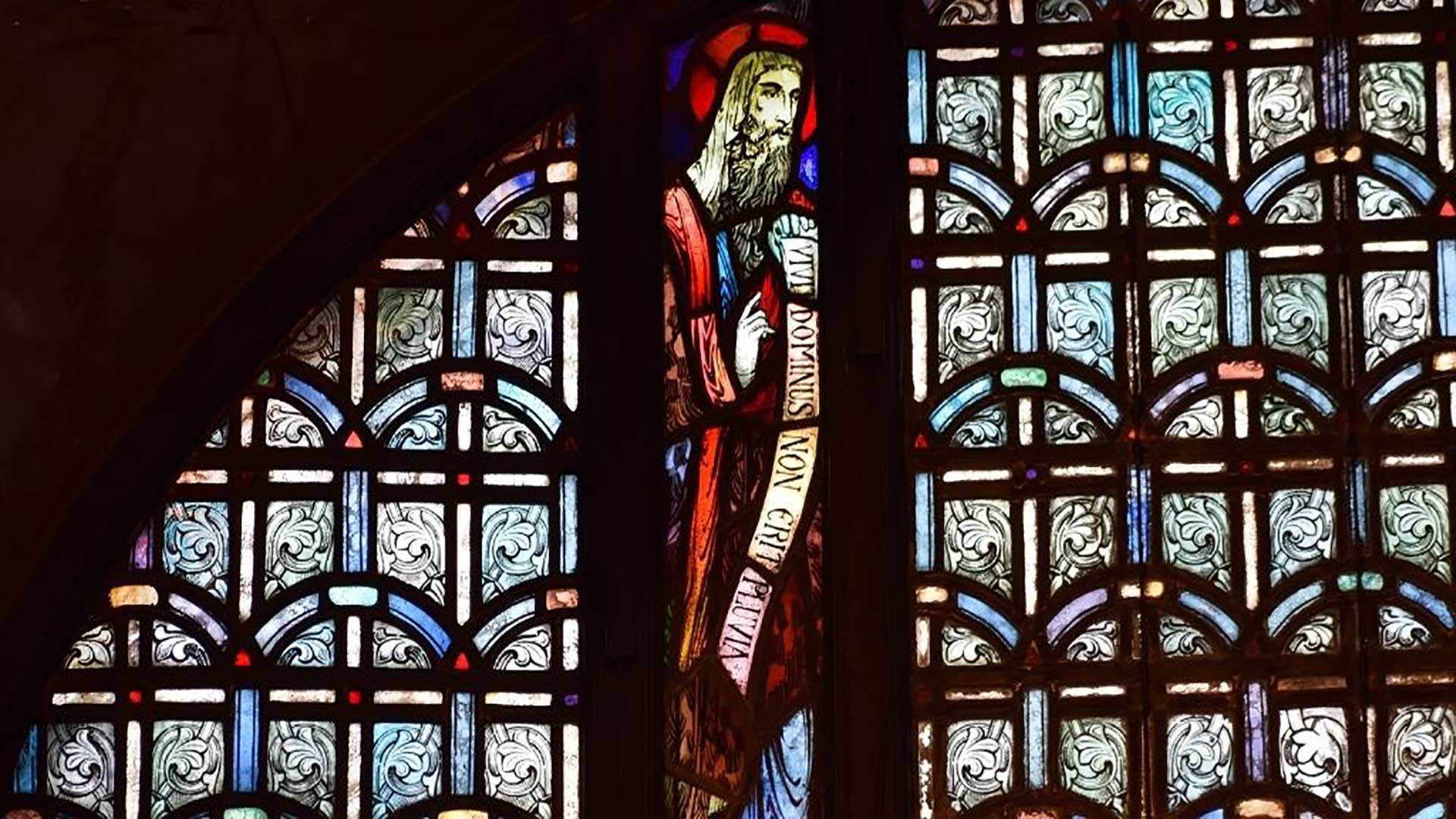High: Priest, Drama, Treason
Today, Palm and Passion Sunday, we will reflect exclusively on St Mark’s Gospel text (14: 1-15, 47), which is dense and rich in concrete details. For a reflection on the other two Readings of the day, which are common to all three cycles, please refer to https://www.oscardenoronha.com/2022/04/10/from-palms-to-the-passion/ and https://www.oscardenoronha.com/2023/04/02/the-suffering-servant/ , my blogposts of 2022 and 2023, respectively
-o-
Several incidents precipitated a crisis two days before the Passover and the Feast of the Unleavened Bread[1]: Jesus’ triumphal entry into Jerusalem; the cleansing of the Temple, and the spin-off indicating the end of Jerusalem and the Temple; Jesus’ authoritative teaching and claims to Divine Sonship; the miracles He worked and the growing multitude around him. All this added up to a situation that could not be ignored.[2]
Hence, the high degree of tension between the Temple aristocracy and Jesus’ supporters at large, symbolised, on the one hand, by the chief priests and the scribes who sought to arrest Jesus, and on the other, by the grateful woman who broke open the lid of her alabaster jar of pure nard ointment and poured out her love.
There was also high treason, best symbolised by the Judas kiss. Jesus was spot on: ‘Truly, I say to you, one of you will betray me… one who is dipping bread in the same dish with me.’ That was insider betrayal out of greed which even made Peter’s denial out of fear look banal: whereas Peter disowned His Master, Judas sold Him. And we have it from our Divine Lord: ‘For the Son of Man goes as it is written of Him, but woe to that man by whom the Son of Man is betrayed!’
Profound words these that would not apply, for instance, to Peter, James and John (the same trio from Mount Tabor) who Jesus thrice found sleeping, unable to keep watch with Him, who was distressed in the Garden of Olives, sat and prayed: their fault was accidental, unpremeditated, for their spirit was willing but the flesh was weak.
On the other hand, absolutely premeditated were the actions of the chief priests, the elders and the scribes late that night. When they sought testimony against Jesus, many bore false witness; when the testimony failed to agree, the high priest took it upon himself to accuse Jesus, and the temple aristocracy joined in condemning Him to death. The garment tearing by the high priest was a sign of outrage prescribed for an officiating judge in the face of blasphemy. [3]
The Sanhedrin, or supreme council and tribunal of the Jews, had religious, civil and criminal jurisdiction. But theirs was more of a cross examination than a trial per se.[4] Early in the morning they handed over Jesus to the Roman Governor Pilate, who held court at that hour, ‘since only the Romans could carry out the death sentence’. To clinch it, the temple authorities emphasized their verdict’s political dimension: Jesus’ claim of messianic kingship, threatening the Pax Romana.
On the other hand, Pilate, especially at his wife’s bidding, indeed took Jesus to be the ‘King of the Jews’. He knew that it was out of envy that the chief priests had delivered him up. Nonetheless, he gave in to them and to the customary public acclamation that, much to his chagrin, favoured Barabbas, a rebel against Roman power and murderer in the insurrection – both of which Jesus was not. That much was enough for Pilate to be on the side of Jesus, whose alleged offence against the Torah did not concern him as a Roman. ‘Why, what evil has He done?’ asked Pilate, but feebly. Then, he played to the gallery; without pressing for coherent answers, he delivered him to be crucified, so as not to risk his own career.
Then in the praetorium (Governor’s residence) there erupts over Jesus ‘the brutal mockery of those who know they are in a position of strength… He whom they had feared only days before was now in their hands. The cowardly conformism of weak souls feels strong in attacking Him who now seems utterly powerless.’[5] They mock him, strip him, and lead Him out to crucify Him. Most likely they are supporters of Barabbas.
And what of Jesus’ supporters? They probably remained hidden out of fear. In a way, they too betrayed Jesus, like so many who fail to bear Him witness today. That is when passersby step in and do the honours. Look at Simon of Cyrene,[6] who promptly agreed to carry Jesus’ cross to Golgotha, while the womenfolk[7] looked on, helplessly, from afar. And finally, when Jesus breathed His last, and the curtain of the temple tore in two, the centurion (Roman commander) exclaimed, ‘Truly, this man was the Son of God!’
A late realisation, almost in vain? Yes, but Jesus’ death was not in vain. ‘God put [Jesus] forward as an expiation by his blood’ (Rom 3: 23, 25) All things considered, Caiaphas’ words about the need for one man to die, to save the nation (and the world, as St John points out) fulfilled the content of Jesus’ mission. And alas, in a moment of high drama, the Jews, declared, ‘We have no king but Caesar’, unwittingly siding with Rome and renouncing Israel’s messianic hope.
The irony of ironies is that in 70 A.D. both Jerusalem and the Temple were destroyed by the very Romans that the Jews had sided with, for it was written, ‘I will strike the shepherd and the sheep will be scattered.’ And then they had no Jesus to rebuild it.
[1] Passover is the first night of the seven-day, annual feast of unleavened bread during which the Israelites ate only unleavened bread, as a commemoration of their Exodus from Egyptian bondage. Since they left Egypt hastily, with no time to let the bread rise, they made their bread without leaven (yeast) on that very first Passover night.
[2] Cf. Joseph Ratzinger, Jesus of Nazareth: Holy Week, p. 168.
[3] Gnilka, Matthausevangelium II, quoted by Joseph Ratzinger, p. 178.
[4] Op. cit., p. 176
[5] Op. cit., p. 182
[6] There is no indication that Simon knew Jesus. He was a Jew who resided in North Africa and happened to be in Jerusalem at the time of the Crucifixion, and later became his disciple and missionary.
[7] ‘Mary the mother of Joses’: Joses was a relative of Jesus.
Faithful to the End
Last Sunday, we had a look at the Davidic covenant that in due course would be replaced by the New Covenant. Today, Jeremiah the prophet preannounces this Covenant, while Jesus explains its nature: a covenant of love based on His death on the Cross. It may be noted that the earlier covenants were provisional, of a material nature, and linked to a nation; they were a long preparation for this new, spiritual, eternal and universal Covenant.
That explains the joy with which the otherwise ‘Weeping Prophet’ Jeremiah makes the announcement to the Judeans exiled in Babylon. You will hear him thus in today’s First Reading (31: 31-34): ‘Behold the days are coming, says the Lord, when I will make a new covenant with the house of Israel and the house of Judah…’ This was not a covenant to be engraved on stone, as in the days of old, but upon hearts (which the Jews regarded as the seat of wisdom and willpower).
Would the survivors of the two divided kingdoms honour the covenant? The answer would manifest itself when Jesus came to the world four centuries later. Meanwhile, the cold reception that the Divine Babe received that December night foreshadowed His ministry’s lack of ‘success’ (as the world sees it). But it was not God that failed – He never will – but the Jewish people who had failed their God. Their bad decisions came home to roost. Look at how the Jewish state crashed at the hands of the Romans in 70 AD – a vindication of what Our Lord had foretold. The issue of the Jewish dispersion, persecution and later unification still dogs contemporary world affairs. The problem with the Jews was that they had their eyes set on their country’s freedom and glory; but alas, in their worldliness, they failed to see that mighty sin militated against their lofty wishes.
As for the Son of God, he was precisely targeting the destruction of sin. He did not come to the world to save His country as the people would like it, but to save His people from their greatest enemy – sin. He would even die to destroy sin, but none of that seemed to matter to the political and religious leaders and their hangers-on in Jerusalem. They were all so self-centred, and warped in their doctrine, that their country was their everything. They were convinced that the world would be saved through them alone.

The Scripture, on the other hand, was clear as daylight, yet the Jews failed to see the writing on the wall. Had not Isaiah (56: 6-7) quoted God as follows: ‘the foreigners who join themselves to the Lord [...] these I will bring to my holy mountain [...] for my house shall be called a house of prayer for all peoples’? This came to pass in today’s Gospel text (Jn 12: 20-33), when Gentiles – Greeks to start with – sought a meeting with Jesus. They first approached Philip, attracted by his Greek name, and Andrew took them all to Jesus. Here is an indication that the Lord would not wait indefinitely for the Jewish people to take the Covenant seriously. His hour had arrived....
The hour had indeed arrived for the Son of Man to be glorified on the Cross. But what glory was there in dying? In the eyes of the world, none! But God’s ways are different from our ways... To get the message across, Our Divine Master employs the analogy of a grain of wheat that falls to the ground and perishes, to bear much fruit. By the same token, when you and I die to ourselves (that is to say, set aside our sinful ways and embrace God’s) we will be born again; he who ‘hates his life in this world’ (loves God more than self) will save himself for eternity. Jesus showed the way by accepting his imminent death – and soon a voice from Heaven endorsed it, saying, ‘I have glorified it [in the river Jordan and at Mount Tabor], and I will glorify it again.’
Now, could the voice from Heaven be Greek to anyone who had ears to listen? The Chosen Race would soon be seen in their true colours. For His part, Our Lord, with loud cries and tears (which attested to His human side) offered up prayers and supplications to His Father who could save Him from death, but at the same, remained obedient and faithful to the end, as we learn from the Second Reading (Heb. 5: 7-9). In this way, Jesus became the source of salvation to all who obey Him and now challenges us to entrust our lives into His hands. He is always faithful; it is we who fail Him… and finally, through our own fault, fail miserably in our endeavours! He longs for us who are made in His image and likeness, but sadly, we wander away.
This Lent, therefore, let us resolve to change our ways, praying: ‘A pure heart create for me, O God!’ (Ps 51: 12) Let us humbly seek His mercy, kindness, compassion. Let us also pray for other transgressors and sinners like us: that we may form a community ever faithful to the Lord our God and be blessed with the joy of His help.
Konkani Saga in the Roman Script
March 13, 2024Konkani pronunciation chart,Generative grammar in Konkani,Konkani proverbsBook Review
The Konkani language is written in many scripts. Ricardo Cabral’s latest offering, Konkani in the Roman Script: a Short Grammatical Study, is a welcome addition to the limited bibliography on the subject. It maps out Konkani’s saga from the time Roman script made an entry into Goa, in the sixteenth century; and more importantly, the book earnestly proposes a modified script.
Before elaborating on the historical “Romanization process”, Cabral looks at fragments of the linguistic history of the mull Goenkar (original natives): the Gauddas and Kunnbis living around the foothills of the Verna-Nuvem plateau. Stating that “the first dialect that has to be taken note of is the Gaudda/Kunnbi dialect”, the author goes on to list its salient phonetic and syntactical features.
Konkani developed a complex structure comprising dialects from the North (up to Malvan) and South (up to Mangalore), with Antruzi, Kunnbi, Shashti, Bardezi and Koli forming the central group. As a result of the immigratory waves from the north and south of the present-day territory of Goa, different dialects of Konkani got integrated down the centuries. That was the position at the time the Christian missionaries began what would turn out to be a grand linguistic enterprise. The Jesuits and the Franciscans naturally chose to write in the Roman script, which was common to Portuguese, Latin and English, and was easier to print.
Cabral traces three developmental phases of Konkani in the Roman script: first, what he calls the Eureka phase, “when all things for the foreign missionaries were objects of wonderment” (16th-19th centuries); then, the middle or Bombay Blast phase (end of 19th to mid-20th century), for the then British Indian metropolis was the nerve centre for Konkani productions in the Roman script; and finally, the modern, consolidation phase (mid-20th to early 21st century). Noting that it was not simple for the missionaries to transcribe the sounds, much less standardise the orthography, Cabral gives examples of how writing in Konkani evolved from being heavily dependent on Latin and Portuguese phonology to trying to find an independent script in contemporary times.
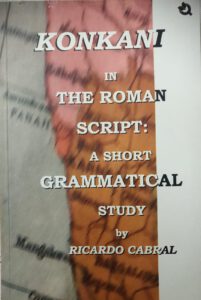
It is not clear why Cabral titles the second chapter “Etymology” when it deals with word or lexical classes as in a traditional grammar. Verbs are then treated more in detail in the third chapter; and it is only in the fourth chapter that we catch a glimpse of the alphabet. It is not always easy to find apt English examples to illustrate sounds in Konkani; quite understandably, the pronunciation chart of vowel-and-consonant sounds in Konkani (ê; fuloi) and their respective phonetic illustrations in English (say /eɪ/; ‘boy’ /ɔɪ/) has a few mismatches.
Whereas the phonetic transcription of some Portuguese words needs to be revisited (e.g. fixo is not /fikso/ but /’fiksu/), the author is right about how hard and soft sounds can make or break. For instance, in church and elsewhere, readers and speakers often fail to distinguish between killo and kil’lo, mellem, mel’lem and mell’lem. Cabral’s table of allophones thus comes across as a valuable learning aid for a language loaded with a variety of phonemes and graphemes.
The general reader is sure to enjoy the chapter on word formation. Cabral elaborates on three types of Konkani words: primitive, derived and loaned. ‘Reduplication’ is an interesting, largely onomatopoeic, process that Konkani words have undergone, giving us picturesque words like khoddkhodd (shivering), davon-davon (hurriedly), poishean poiso (every paisa), and so on. Cabral gives a sprinkling of loan words from Sanskrit, Arabic, Persian, Kannada, Portuguese, French, Marathi, English, Tullu and Hindi. However, the cited ghurghuret (water pot) is not originally a Konkani word but corrupted from the Portuguese gorgoleta.
In chapter six, ‘Morphology’, Cabral lists hyponyms, homonyms, homophones, polysemes collocations, and so on. And whereas in chapter seven, we find a conventional treatment of Syntax, with a good dose of illustrations, the subsequent chapter tackles a relatively new area: Generative Grammar. Cabral deserves credit for the structural analysis undertaken, by devising much needed test-frames for sentences and tenses in the language. It is a brave effort to modernise the grammatical approach to the Konkani language.
In the said chapter, Cabral also presents a modified alphabetic principle, in an attempt to rationalise the Roman script for Konkani; he highlights the differences between x/sh; i/y; d/dd; t/tt; n/nn and proposes the tilde as sole nasal marker, allowing m and n to be used exclusively as consonants. His makes a compelling case for well-defined orthographic rules, a step in the right direction.
In the penultimate chapter, on Ergativity, Cabral correlates Konkani with Latin and Sanskrit. He states that, there being no formal passive voice in Konkani, past and perfective tenses double up as seemingly passive in some tenses of transitive verbs. He indicates three ways to tell between transitive and intransitive verbs in Konkani. His catalogue of over 300 transitive and intransitive verbs, with their exceptions and meanings in English, is a ready reckoner.
At the end of a full course meal, the closing chapter, titled ‘Miscellaneous’, is a veritable dessert. It offers close to a hundred idiomatic expressions; several figures of speech; interesting proverbs; many puzzles and riddles (parkhonni/umanni); person and place names in Goa; and a handy glossary of a thousand Konkani words. Much as the book could do with tighter editing and better proofing, readers are sure to be charmed by its final chapter.
Ricardo Cabral, PhD, a teacher educator by profession, who retired from the Goa State Council of Educational Research and Training (SCERT) and has authored two books on education in Portuguese Goa, is deeply concerned about how Konkani in Goa has to reel under tremendous pressure from India’s two official languages: Hindi, given the large-scale immigration of its speakers; and English, given the Goan penchant for the language. He fears that soon there may be very few Goans speaking Konkani. Hence his effort – “to make the knowledge of Konkani available not only to those who want to learn the language but also to those who want to learn about the language, especially Goans in the diaspora” – is something that Goa ought to be grateful for.
KONKANI IN THE ROMAN SCRIPT, by Ricardo Cabral (Panjim: Qurate Books, 2023. Rs 735/-)
First published in Revista da Casa de Goa, Series II, No. 27, March-April 2024, pp. 63-65
https://online.fliphtml5.com/bcbho/agcy/#p=1
Love Him, who is the Light!
On the fourth Sunday of Lent, we look at the Davidic covenant that, like the previous ones, was not respected; it was eventually replaced by the New Covenant, with the coming of Jesus Christ, Son of David, as the Light of the world.
Today is also called Laetare Sunday, from the first few words of the traditional Latin entrance verse for the Mass of the day. ‘Laetare Jerusalem’ (‘Rejoice, O Jerusalem’) is Latin from Isaiah 66: 10.
In the First Reading (2 Chron 36: 14-16. 19-23) we see that the people of Judah had failed to keep the covenant; they had ‘polluted the house of the Lord’ and mocked at God’s messengers. Then the inevitable happened. In 597 BC, King Nebuchadnezzar II of Babylon captured Jerusalem and sent the king and his people into exile. For 70 years thereafter, they turned to God in their desolation and kept sabbath holy. Eventually, God in His mercy inspired the Persian king Cyrus, who had by then conquered Babylon, to let the Jews return to Judah and rebuild the Temple that the Babylonians had destroyed.
This Second Temple was awe-inspiring from the religious as well as architectural point of view. But alas, it was only a marvellous shell disguising the emptiness of the people’s lives. Not only did Judah continue to be coveted by foreign rulers, including the Greeks and the Romans; to curry favour with the authorities, the Jews were willing to offer sacrifices to their deities. Herod even erected a golden Roman eagle on the Temple. The Pharisees rose partly as a reaction to the Jewish submission to foreign influences and syncretistic practices (but eventually the remedy became as serious as the disease)….
It was against this background that, five centuries later, God sent His Only Son Jesus to announce the Good News of Salvation. Jesus frequented that very Temple, preached there and even cried at the thought of its impending destruction. He presented Himself as the Temple of God – but He was misunderstood, maligned, rejected. When He promised to rebuild the Temple in three days, He was referring to His own Death and Resurrection. But the people who cared not to see beyond the end of their noses wrote Him off. And the rest is history. Jesus built His Holy Church, to which we are happy to belong, whereas in 70 AD the Jewish Temple was reduced to rubble by the Romans and there began the dispersion of the Jews.
That throws into sharp focus what Jesus says to Nicodemus in today’s Gospel text (Jn 3: 14-21): ‘As Moses lifted up the serpent in the wilderness, so must the Son of God be lifted up, that whoever believes in Him may have eternal life.’ And then He cautions: ‘He who believes in Him is not condemned; he who does not believe is condemned already, because he has not believed in the name of the Only Son of God.’

It is interesting to note that Nicodemus was a Pharisee and member of the Sanhedrin; he, who admired Jesus’ teachings, first visited Him at night! He was quite likely a secret disciple and is known to have reminded fellow members that Jesus had a right to a hearing before being judged. He appeared next after Jesus’ crucifixion, bringing along the customary spices to anoint the dead body – a large amount at that, which turned it into a “royal burial”,[1] in the words of Pope Benedict XVI, in his book Jesus of Nazareth.
Meanwhile, what is that 'serpent in the wilderness' that Jesus refers to in his conversation with Nicodemus? It refers to a scene from Numbers 21, where the Lord had told Moses to lift up a pole with a bronze serpent on it, so that whoever looked upon it would be healed and delivered from God’s judgment.
Likewise, we must regard Jesus on the Cross as our only salvation! But do we? It isn’t an exaggeration to say that the Christian world stands in need of liberation from many temptations and vices. It is as though we too have ‘polluted the house of the Lord’; we are indeed walking the tightrope with syncretic and idolatrous practices, putting the Lord to the test. We are destined to have a share in the kingdom of God, in God's eternal life, yet we go to pick up two pennies in the street, risking the loss of that great fortune.
Let us not be half-hearted or just secret admirers of Jesus Christ. Let us come out into the open and declare our allegiance and solidarity. Rightly so, for with Him we have everything; without Him, nothing! Without Him, we would be condemned and dead already. St Paul in the Second Reading (Eph 2: 4-10) calls our attention to the fact that ‘God, who is rich in mercy, out of the great love with which He loved us, even when we were dead through our trespasses, made us alive together with Christ (by grace you have been saved), and raised us up with Him.’ He is indeed the Way, the Truth and the Life. He is the Light.
Let us be children of the Light and love Him who is the Light of the World. Only then will the New and Eternal Jerusalem rejoice.
[1] Ratzinger, Joseph. Jesus of Nazareth. Holy Week: from the entrance into Jerusalem to the Resurrection. California: Ignatius Press, and Bangalore: Asian Trading Corporation, 2011, p. 228.
Calling a spade a spade
On the first two Sundays of Lent, we pondered the Noahic and Abrahamic covenants. This Sunday, we dwell on the Mosaic covenant, one of whose highlights is the ban on the worship of false gods. This is a central idea of our faith, echoing as it does in the Gospel text that shows Jesus in an unprecedented act of expelling those who had desecrated God’s house. He is the God of mercy and love, but also of justice and zeal for His Father.
The First Reading (Exod. 20: 1-17) reminds us of the identity of the Lord our God. He delivered not only the Jews, out of bondage, He delivers us at every moment of our lives. How, then, can other gods ever flash before our eyes? Our loyalty must be only to our God who saves! Let alone inanimate, graven images; we ought not to bend down or serve any other idol – things or humans (many of whom, alas, have sold their souls!)
God has issued the Decalogue for our easy reference and guidance; whoever bypasses it, does so out of convenience or arrogance, not inability. And woe to those who think they can pull the wool over our eyes. No manner of theological deftness, in an attempt to please everyone, can hoodwink God…. Then, why can’t we simply call a spade a spade? Isn’t our communication supposed to be ‘yes, yes; no, no’? (Mt 5: 37) If not, the claim that when God is for us none can be against us (cf. Rom 8: 33) will come across as mere rhetoric…
In today’s Gospel text (Jn 2: 13-25) Jesus is portrayed as our role model par excellence. He acted single-handedly and single-mindedly, against those who had idolised mammon. ‘Think ye, that I am come to give peace on earth? I tell you, no; but separation,’ he had forewarned. And separation is what He brought about between the authentic and the fake in His Father’s house. He drove the latter out with a whip of cords and overturned their negotiating tables. His disciples remembered that it was written, ‘Zeal for Thy house will consume me,’ and this was now playing out before their very eyes.
Humanly speaking, we tend to think that Our Lord was wrong in what He did. That is not true; Our Lord proceeded with extreme care, but did not fail to do what He had to do – to call a spade a spade! According to the Blessed Anne Catherine Emmerich, who experienced visions of the life and passion of Jesus, Our Divine Master had gently admonished the vendors on an earlier occasion, corrected them on a second, warning them that he would act on the third occasion, if any.
It is no surprise that the Jews tried to checkmate Jesus, saying, ‘What sign have you to show us for doing this?’ During Our Lord’s three-year public ministry, there were signs galore – healing the sick and bringing the dead back to life; what else could one ask for? Besides, it was all written in the Jewish scriptures, from times immemorial; the Pharisees and the Scribes, the teachers and leaders of Israel, knew it all very well – ever since they sighted the Star of Bethlehem! There was obviously a lot of malice in trying to play that down.
It was now already the eleventh hour. The time for the final showdown had arrived. However, when Our Lord announced that He would destroy the temple and rebuild it in three days, the said dissenting Jews were flummoxed. With them was fulfilled Isaiah’s prophecy, which said: ‘You shall indeed hear but never understand, and you shall indeed see but never perceive.’ (cf. Mt 13: 14) ….
And what about you and me? It is as though the rest of Isaiah applies to us! Haven’t our hearts grown dull; aren’t our ears heavy of hearing and our eyes closed? Note Our Lord’s words to those who take Him for granted: ‘Truly, I say to you, many prophets and righteous men longed to see what you see, and did not see it, and to hear what you hear, and did not hear it.’ (Mt 13: 17)
Let us, therefore, appreciate that God’s commandments help us establish a personal rapport with God and our fellow human beings. To us who are in pursuit of the truth, they provide a roadmap and spare us the pressures of our crazy times. But then, are we any different from the Jews who expected signs, and the Greeks who demanded knowledge?
St Paul in the Second Reading (1 Cor 1: 22-25) says that Christ was a stumbling block to Jews and folly to Gentiles. What about us? Are we ready to preach Christ crucified and stand by the folly of the Cross? Let us ask the Lord our God for the light to see His commandments clearly; for the strength to act accordingly, calling a spade a spade; and pray for that much needed grace to get to the depth of the Paschal Mystery.
Matter of life and death
February 25, 2024Mass Readings
There is a culture of life and a culture of death. Quite ironically, while we live in a world that prizes life, we are continually surrounded by agencies of death. We feed the body and starve the soul; we value the life of the body and have no qualms about the death of the soul. Ours is therefore a life in death, and the sooner we realise it the better.
Against that backdrop, can the First Reading (Gen 22: 1-2, 9, 10-13, 15-18) make any sense to contemporary man? That Abraham could instantly agree to sacrifice his son to please God, may seem absurd; we may even dismiss the passage as fictional.
The fact is that Isaac was a son of promise, so how could God ask for a sacrifice? But then, Abraham suspended his judgement and was ready to do so, as a sign of his faithfulness to God who had given him the son. His unparalleled act of faith prompted God to announce a beautiful plan, as seen from the following words he said to Abraham: ‘I will indeed bless you, and I will multiply your descendants as the stars of heaven and as the sand which is on the seashore.’
But alas, Abraham’s descendants betrayed his faithfulness; they systematically spurned multiple divine covenants – until God deigned to send his only Son Jesus to the world, in a striking parallel to Isaac’s life and death. Both Isaac and Christ were only sons, born supernaturally, as sons of promise; both came with the message that God still loved the world; both were sacrificed, on mount Moriah, which, if not the same as Golgotha, is thereabouts. Thus, Isaac was the symbol, Jesus the Reality.
St Paul in the Second Reading (Rom 8: 31b-34) sets us thinking: ‘He who did not spare his own Son but gave Him up for us all, will he not give us all things with Him?’ Of course, He will. And if God is for us, who can be against us? If this be true, what is the point of ‘the weariness, the fever and the fret / Here, where men sit and hear each other groan’? Or as another poet put it, ‘What is this life if, full of care, we have no time to stand and stare?’ In fact, in the present chapter of the Letter, St Paul sings a paean to God’s faithfulness and love.
Elsewhere, the Lord reminds us of a truth that often goes unnoticed: ‘Look at the birds of the air; they neither sow nor reap nor gather into barns, and yet your heavenly Father feeds them. Are you not of more value than they?’ (Mt 6: 26) Indeed, we are. Why, then, can’t we stop worrying and start thinking of how best to let His kingdom come, on earth as it is in Heaven? Let us believe and trust in Him who knows and can do all things; let us gaze at His face.
Today’s Gospel text (Mk 9: 2-10) reveals to us Jesus’ purpose of taking with Him Peter and the two Sons of the Thunder, James and John, up a high mountain apart by themselves: He did so to let them know His identity and destiny. And they, who would soon be destined to witness the Agony in the Garden of Gethsemane, would better have their faith fortified right away.
Then, Jesus was transfigured before them. Peter, afraid and not knowing what to say, proposed to build three tents – for Jesus, Moses and Elijah. In fear and at the same consoled by what he had seen, he succumbed to the human tendency to bring the supernatural down to the natural. But when there appeared to them Elijah with Moses, who spoke to Jesus, it was clear that the Transfiguration was no mean event, surely not something about relaxing or standing or staring. And what is more, a cloud overshadowed them, and they heard a voice saying, ‘This is my beloved Son; listen to Him.’
What else do we need to convince ourselves that Jesus is our Lord and God? Not only does His divinity stand confirmed, the prophetic role of Elijah and the leadership of Moses are endorsed. As for us today, it ought to convince us to ‘strive first for the kingdom of God and his righteousness, and all these things will be given to you as well.’ (Mt 6: 33). In short, we have to be transfigured to be entitled to participate in the Lord's Resurrection.
We require nothing other than His message, to realise that earth is a temporary tent; that those who want to save their life will lose it, and those who lose their life for God’s sake will find it? (cf. Mt 16: 25). This is indeed a matter of life and death, and Lent is here to let us know.
Let’s walk right back to God!
February 18, 2024Mass Readings
Lent is an apt time for reflection and introspection. The Readings are so designed as to let us delve deep into our Christian being. They recall the times when God interacted with man and, closer to our times, sent His Only Son to the world. They take us back to the basics, showing a consistent theme running from the beginning of humanity to our days.
The First Reading (Gen 9: 8-15) speaks of the first Biblical covenant between God and humankind, in the person of Noah. After the deluge, when a new humanity arose, purified by the waters, God promised to never again flood the earth. God stooped down to hug humanity in a touching scene of an everlasting love.
It may be recalled that the Noahic covenant had become necessary after the one established with Adam had failed. In the Gospel text (Mk 1: 12-15) we encounter the Second Adam, Jesus Christ: He is tempted in the wilderness, just as Adam and Eve were in the Garden of Eden, but unlike them, Jesus stands up to the forces of evil.
Our Lord’s exhortation – ‘The time is fulfilled, and the kingdom of God is at hand; repent, and believe in the Gospel’ – is thus a clarion call to reflection and introspection that will lead to repentance. The wilderness is a privileged place for Jesus’ encounter with the Father; the forty days of solitude that He spent there evoke the forty days that Moses spent on Mount Sinai and the forty years of God’s people in the desert. Our Lenten season is a reenactment of those days.
You and I live in a worldly wilderness, a moral desert, a spiritual wasteland. But we may rest assured that, like the angels who ministered to Jesus while he was tempted by Satan, our Baptism helps us to withstand the evil forces of the world. We are not told explicitly what the ‘kingdom of God’ consists of, but a certain realisation wells up in the deepest recesses of our hearts, in the form of our inner conversion; it is a promise that we will one day partake in the merits of the Lord’s Resurrection.
Finally, St Peter in the Second Reading (1 Pet 3: 18-22) draws a parallel between the water that saved Noah’s eight and the water of Baptism that saves us. It speaks volumes of the Lord’s faithfulness. As the Psalm sings, ‘Your ways, Lord, are faithfulness and love for those who keep your covenant.’
Our prayer therefore should be that the Lord teach us His ways and let us walk in His truth; that He have mercy on us and remember us. There is no place for doubt, for the Lord is good and upright. However disastrous the circumstances of our lives may be, He shows the path to those who stray. Lent is thus that period par excellence when, with a contrite heart, we may walk right back into God's bosom.
Moving Corpses Miraculously Cured
February 11, 2024Mass Readings
Today is the optional memorial of Our Lady of Lourdes, superseded by the Sunday liturgy. Lourdes is the world’s centre of miraculous cures, and coincidentally two Readings of today focus on illness; they are replete with the word ‘leprosy’, a disease that for centuries awaited a cure. Like cancer today, leprosy would in the remote past send shivers down the spine. And much as we may think it has been eliminated, it continues to be a cause for concern, for where it was once eradicated, it has since resurfaced. The only difference is that while leprosy today is easily curable, perhaps the associated stigma is not. And few would realise that the stigma of sin is infinitely worse.
In the First Reading (Lev 13:1-2, 44-46) there is both the stigma and the pain. Moses, who was a member of the priestly tribe of Levi, was also the author of the Book of Leviticus. It is understandable that, at a time when physical abnormalities were attributed to sin, the Book should convey guidelines on how bodily diseases threatening society had to be handled. But we have to also capture the message of divine forgiveness and obligation of human sanctification that the Book contains.
Alas, how despicable was the treatment meted out to lepers; in fact, that was no treatment but condemnation! A leper’s distinguishing mark was torn clothes, hair hanging loose, lips veiled, and the cry, ‘Unclean, unclean’. He was not only regarded as unclean, he would be in that condition, alone, nameless and forgotten, in a habitation outside the residential areas, until Death took pity on him. Let those who baulk also remember what, not so long ago, victims of the much-hyped covid-19 were made to feel….
That is to say, our fallen nature remains unchanged – until we are touched by the Lord of Hosts, who is none other than Jesus Christ. It is evident from the Gospel text (Mk 1: 40-45) that He had both the compassion to reach out and the power to cure whoever needed His help – and who doesn’t? When the leper beseeched Him – ‘If you will, You can make me clean,’ Jesus was moved by pity; He did not stand on ceremony, but went ahead and cured him – ‘I will; be clean!’ He said. And the cure was powerful, instantaneous, undoubtedly supernatural.
Yet, He charged the man to say nothing to anyone but the priest. He makes a reference to Moses: ‘… and offer for your cleansing what Moses commanded, for a proof to the people.’ The proof consisted in changing his life for the better – his sanctification – what could be a greater proof that the Lord had touched him? In fact, Jesus did not want anyone to proclaim Him lest others should think that His Kingdom was of this world; He had not come to liberate their country but their souls. It is quite another matter that the man who was cured went out and talked freely about Jesus… What do we do? The unclean became clean; no wonder there was joy in his heart and a spring in his step. What about us?
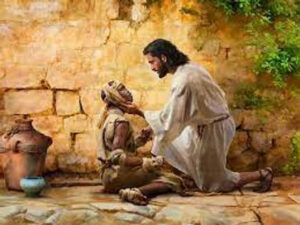
Who on earth has the power to cure moving corpses? Only Our Lord Jesus Christ: He washed away not only the pain but the stigma too. Quite significantly, St Lazarus – from Jesus’ parable of the wicked rich man (Lk 16: 19-31) – is the patron of lepers and against leprosy. Closer to our times, in Goa, St Francis Xavier would say Mass at the leper home in the suburbs of the old city on Sundays and tend their wounds with his own bare hands. In Sri Lanka, the same was true of St Joseph Vaz, who provided a healing touch to lepers and cholera patients alike.
Yet the disease did not touch those messengers of love. Of course, there is, on the other hand, the story of the Belgian missionary Fr Damien who worked in a Hawaiian leper colony, where he contracted leprosy himself. Similarly, in a secular setting, haven’t we heard of cancer specialists that have died of cancer, and paediatricians who have remained childless? That is the mystery of life. None can rightfully demand a miracle or even expect any sort of supernatural immunity.
Hence, St Paul’s formula in today’s Second Reading (1 Cor 10: 31 – 11: 1): he exhorts us to do everything for the greater glory of God. We have to win others over and let them be saved. In the remote past, even a lesser skin disease was feared for its uncleanliness, in our days, it is our stubborn sinfulness that must be feared. We ought to have faith and seek mercy at all times, from Jesus who is the Bread of Life. We are no more than moving corpses awaiting His miraculous cures.
Miracles and His Mission
Today’s Readings speak very especially to the mind and heart of modern man. They dwell on suffering, which in our times has assumed unprecedented proportions; they show how Jesus tackled people’s pain and anguish through His many miracles; and finally, they point to what our response to suffering ought to be in the humdrum of our lives.
The First Reading is taken from the Book of Job (7: 1-4, 6-7), which is a gem of world literature. Not only does it portray a deeply human drama of suffering and a very sublime response, it uses language with warmth of feeling and a healing touch. Job, an honourable man, rich and happy, is mysteriously disgraced. His friends take this to be a punishment for sin but Job, without claiming to be sinless, insists that his life's horrendous disasters are inexplicable.
The point is that suffering in not necessarily a result of personal sin; it can simply be a situation by which God wishes to test our faith. We may fail to understand it, but the Church teaches that suffering purifies and strengthens the souls that God loves. And he loves them all. So, it would be in the fitness of things to accept His rulings and go as far as to love and praise Him in all circumstances. Eventually, suffering works to the advantage of those who have accepted it with resignation.
Job’s story is both contemporary and eternal. He laments the drudgery of life just as we do: aren’t we but slaves to the world, moving from one day to another with chronic feelings of emptiness? Like him, we too long to rest, but then, aren’t we somehow anxious to start another day and get going? ‘I am full of tossing till the dawn,’ says Job, foreshadowing the predicament of the business executive of our times. Our ‘life is a breath’, and there is no denying – paradoxical though it may seem – that bondage to God alone is truly liberating!
The good news in Job’s case is that his health was restored, and he was blessed with twice as much wealth as before, ten new children, and a very long life. A miracle! Mind you, your life and mine may not be as dramatic, yet every moment of it is a wonder. If only we cared to think of the troubles that we have not been subjected to, our hearts would rise up to bless God’s name in thankfulness! We would break out singing ‘I’ve got something that the world can’t give and the world can’t take it away!’ Modern man is speechless vis-à-vis the Lord’s marvellous miracles.
In the Old Testament, miracles were aimed at moulding the Jewish people as servants of God Most High. Great marvels were performed by Prophets Elijah and Elisha, for instance, but alas, Jewish life was continually marked by unbelief, sin and unfaithfulness. Mercifully, God responded with faithfulness. To have humankind believe, He even sent His Only Son, who also wrought wonders – so many, so great and with such great ease – as only God could.

In the Gospel text (Mk 1: 29-39), Jesus, at the very beginning of His public ministry in Capernaum, cures Simon Peter’s mother-in-law and hordes of sick or possessed people. And why? To make known His divine authority and win souls: ‘That you know the Son of Man has authority on earth to forgive sins, I say to you, rise, pick up your bed, and go home.’ (Mk 2: 10-11). Seeking such relief in also a top priority in our days. But Jesus shows us that none of this is possible without a life of intense prayer – something for modern man to mull over – so, He rises early and goes out to a lonely place to commune with His Father in Heaven.
Let’s face it, our souls are like long cramped scrolls waiting to be smoothed out and soothed. Why not entrust our disordered and miserable selves to God? We would soon see His glory and spread the Good News of Salvation! St Paul makes it clear in the Second Reading (1 Cor 9: 16-19, 22-23) that preaching the Gospel ought to become second nature to us; we must proclaim it through thick and thin, without ever making it a ground for boasting or material gains, like the Scribes of old who used to cite texts for their own convenience and extort money from credulous souls.
For his part, the Apostle of the Gentiles made himself ‘a slave to all, that I might win the more.’ It does not mean that he acted in an unprincipled manner; rather, by diminishing himself, he became ‘all things to all men’, to achieve a greater good, that is, win souls for Christ. After all, we are called to be light of the world and salt of the earth – and that is the greatest miracle we may hope to witness in our mission here on earth!
Banner: https://rb.gy/hx42ru
Prophets of faithfulness
Prophets are what you and I are supposed to be. Prophecy is not a relic of the old times but our perpetual mandate as Christians. It is a gift we receive at Baptism, and which we will be able to use optimally so long as we are prayerful and faithful. In our day and age, however, even while we observe Christian prophets on the rise, we must remember that there are prophets and prophets; and it is important to distinguish between true and false ones.
This is not just a contemporary concern; it has existed since times immemorial. In the First Reading (Deut. 18: 15-20), which dwells on the theme of faithfulness, Moses announces the arrival of a mediator between God and Man, a prophet, who will speak to God and convey His message to the people. He is not entitled to interpret the law capriciously. God makes it clear that any such violation is sinful, and the wage of sin is death.
Accordingly, down the ages, Israel was favoured with many prophets but, ever disgruntled, the people consistently rejected them. They broke many covenants, until God, in His love and mercy, decided to send His Son into the world. Jesus became the Prophet par excellence, who exercised His mission perfectly and incomparably. John the Baptist, who was mistaken for that much awaited Prophet, unequivocally pointed to Him as “the Lamb of God”.
As seen from the Gospel passage (Mk 1: 21-28), Jesus in the synagogue, a regular rendezvous of the Jewish community, gave evidence of his messianic role: He taught the people as one who had authority, and not as did the scribes. That is to say, He was faithful to the Father in Heaven and His teachings came alive; on the other hand, the scribes, held as doctors of the Law, interpreted the scriptures as per their whims and fancies.
The Evangelist St Mark describes a typical day in Jesus’ public life in Capernaum, where He prayed in a community and attended to all who came to Him for physical and spiritual relief. Located on the northern banks of Lake Gennesaret (aka Lake Tiberias or Sea of Galilee), Capernaum was Our Lord’s adoptive city. At its synagogue, which He had frequented since childhood, like any faithful Jew, to fulfil the Law, He very significantly launched His ministry.
It is at that same synagogue that the evil one sought to challenge Jesus. Even though he acknowledged Him as the Son of God, the possessed man objected to Jesus’ ministry; he spread the canard that He had come to destroy Israel! The promise from Deuteronomy came alive when Jesus stopped the unclean spirit dead in his tracks.
Would it not be wonderful if God were to act directly in our midst today? But then, aren’t we His instruments, His hands and feet – He the Vine and we the branches? So, it is time we examined if we are being true to our Christian vocation; it is time we looked at our role in our families and in the world at large; it is time we checked how readily we stand by God and adhere to His law, or, instead, promptly jump on the bandwagon!
What are the obstacles in our way? St Paul hits the nail on the head when he refers to our wavering commitment. Married men and women have their own preoccupations about pleasing each other rather than the Lord. It may imply that a life of celibacy is a better sign of prophecy, but the Apostle does not pit himself against the institution of marriage; rather, he urges us, whether married or celibate, to always remain focussed on the Lord.

Prophecy makes the world go round, but at a time when people are becoming distrustful of institutions, governments, science and technology, and the media, we must beware of charming individuals that might try to fill the vacuum. Way back in the sixteenth century, innovators pretended to reform the Church but ended up dividing it. Let us not forget that, with the devil clamouring for our souls, we are ever in a state of siege. Or as Bishop Barron puts it, ‘in a world that has lost its bearings, those who speak the divine truth will, perforce, appear unhinged.’[1]
Hence, a summary of rules drawn up by trusted theologians and outlined by the Catholic Encyclopaedia [2], may be useful to show practically how the doctrine of prophecy is to be applied to devout souls in order to save them from errors or diabolical delusions:
(1) the recipient of the gift of prophecy should, as a rule, be good and virtuous, for all mystical writers agree that for the most part this gift is granted by God to holy persons. The disposition or temperament of the person should also be considered, as well as the state of health and of the brain;
(2) the prophecy must be conformable to Christian truth and piety, because if it propose anything against faith or morals it cannot proceed from the Spirit of Truth;
(3) the prediction should concern things outside the reach of all natural knowledge, and have for its object future contingent things or those things which God only knows;
(4) it should also concern something of a grave and important nature, that is something for the good of the Church or the good of souls.[3]
(5) prophecies or revelations which make known the sins of others, or which announce the predestination or reprobation of souls are to be suspected.[4]
(6) we have afterwards to ascertain whether the prophecy has been fulfilled in the way foretold, with a few limitations.[5]
Let us therefore learn ‘to distinguish true prophecies from the puerile, senseless, and useless predictions of fortune-tellers, crystal-gazers, spiritualists, and charlatans.’[6] The indisputable fact is that God is the alpha and the omega; without Him we cannot live. And a large part of our troubles would be gone if only we had trusted Him rather than the world. Let us, then, harden not our hearts but listen to His voice. He is the rock who saves; we ought to hail and give Him thanks. He cares for us and leads us by His hand, as the Psalm emphasises. There can be no greater blessing than that of being His faithful prophet.
-o-o-o-
[1] https://www.wordonfire.org/articles/barron/priests-prophets-kings/
[2] https://www.catholic.com/encyclopedia/prophecy
[3] These may tell things beyond human knowledge and yet within the scope of the natural knowledge of demons, but not those things that are strictly speaking the objects of prophecy (Ibid.)
[4] Three special secrets of God have always to be deeply respected as they are very rarely revealed, namely: the state of conscience in this life, the state of souls after death unless canonized by the Church, and the mystery of predestination. The secret of predestination has been revealed only in exceptional cases, but that of reprobation has never been revealed, because so long as the soul is in this life, its salvation is possible. The day of General Judgment is also a secret which has never been revealed (Ibid.)
[5] There are some limitations to this rule: (a) if the prophecy was not absolute, but containing threats only, and tempered by conditions expressed or understood, as exemplified in the prophecy of Jonas to the Ninivites, and that of Isaias to King Ezechias; (b) it may sometimes happen that the prophecy is true and from God, and the human interpretation of it false, as men may interpret it otherwise than God intended. It is by these limitations we have to explain the prophecy of St. Bernard regarding the success of the Second Crusade, and that of St. Vincent Ferrer regarding the near approach of the General Judgment in his day. (Ibid.)
[6] Ibid.


